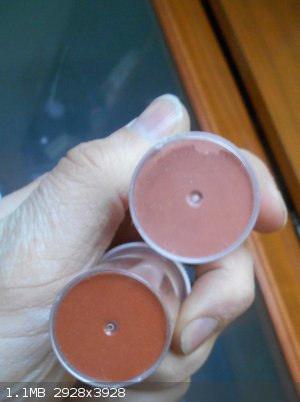
RogueRose - 24-2-2018 at 14:40
My first venture into trying to make CuSO4 was a total mess! I didn't realize the spray that would effect things surrounding the cell so I had some
corrosion on some things around it, lol. Anyway, I don't remember what concentration of H2SO4 I used, I'm guessing probably 10-15% and I used a
copper anode and cathode. I tried using a 3.3v and 5v supply (IDK what amperage, it was an old computer supply so it probably had a fair amount,
especially on the 5v rail).
After a couple hours of running the cell I had this "foam" that had built up around one of the electrodes, I forget which one now, but it was a
brown/red color that was extremely slimy and was definitely copper as rubbing it between the fingers on my gloves gave a shimmer.
After watching Chem Players video on making copper nano particles using CuSO4 and ascorbic acid the resulting particles that needed washed after it
was made, looked very similar to what he was washing at the end with ethanol.
Now that I think a little more, I'm wondering if it might be Cu2O as it has a red color but I'm also thinking that this might be soluble in the H2SO4
and it would have created more CuSO4 in solution instead of clumping up.
I may have some pics of this, I'll have to dig it up. The process did make a good bit as it was about the size of 1 - 1.5 large eggs (yeah odd thing
to compare it to but it grew in a shape that was kind os similar as well, so there you go).
When I allowed it to dry, it seemed to retain water for a LONG time, probably at least 3-4 weeks when sitting in a deep petri dish on the window sill
and there was solution extracted with it - so IDK if that is a trait of nano particles.
Has anyone had any experience with this and know what it may be?
BaFuxa - 25-2-2018 at 08:52
Interestingly enough I did this chem player's synthesis a few days ago. First batch I let it overheat on the hot plate and got Cu2O. The second one I
did right, it looks pinkish and should be Cu Nps.
You need anions to reduce the Cu cations. The Cu particles are then all surrounded with these anions ( from ascorbic acid or citric acid) that repel
each other thus keeping the particles from clumping together. So surely the electrolysis should reduce your cations but would this have the same
effect as the ascorbate or citrate anions ? I would say the Van der Waal force can only be overcome by electronic repulsion between the anions.
To test for Nps you can try to shine a laser through your solution, if you see a laser beam through it, you have Nps.

[Edited on 25-2-2018 by BaFuxa]
NEMO-Chemistry - 27-2-2018 at 16:25
That is a really pretty colour! Copper chemistry is endless fun
